MIPI Low Latency Interface
MIPI LLI
.jpg?width=1800&height=900&name=Banner%20Images%20-%20MIPI%20(1).jpg)
Developed by: Low Latency Interface (LLI) Working Group (HIBERNATED WORKING GROUP)
Enabling sharing of resources to eliminate a memory chip
Quick Facts
-
Fundamental Features
- High performance
- Low power
- Low EMI
- Multiple service classes
- Inter-processor communication
- Support asymmetric communication
-
Physical Layer
M-PHY
-
Use Cases
- Sharing processor resources
- Eliminating memory chip
Get the Specification
-
Current Version
MIPI LLI℠ v2.1 (November 2014)
Member version
Overview
General Info
-
Overview
MIPI Low Latency Interface, MIPI LLISM, provides a point-to-point interface between the application processor and modem/baseband processor.
Note: The full specification is available only to MIPI Alliance members. For information about joining MIPI Alliance, visit Join MIPI.
-
Implementation
MIPI LLI enables the baseband processor to access the application processor’s dedicated DRAM memory for baseband processor operations, eliminating the need for the baseband processor to have its own dedicated DRAM chip.
The interface reduces pin count, saves board space and reduces the bill of materials for a device. Elimination of a discrete chip also helps reduce system-level testing for OEMs to shorten design cycles and expedite time to market.
-
Performance Highlights
MIPI LLI uses the MIPI M-PHY physical layer. The MIPI LLI stack also provides a PHY adapter, data link layer and transaction layer.
The interface also allows for sideband signals between the two chips to further improve overall system communication. Operation on MIPI M-PHY can reduce system power by leveraging the MIPI M-PHY sleep and hibernation power modes.
MIPI M-PHY can also scale data throughput. The connections employ memory-mapped transactions for communications via native protocols such as Open Core Protocol and Advanced Microcontroller Bus Architecture.
Industries






